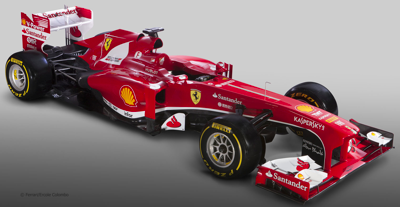
Definitions of beauty change over the centuries but the F1 car endures for a year. When Alexandros of Antioch was chipping away at the Venus de Milo in 100BC it’s doubtful he would have imagined that people would be calling a racing car a thing of beauty in a couple of thousand years. He might not have understood downforce and front wings or have even heard of Monaco, but the 1st century sculptor would not have had difficulties imagining the intangible aesthetic appeal that results from something with one purpose.

The Ancient Roman architect Vetruvius showed that there were three important themes for a creator – firmitas, utilitas and venustas. Strength, functionality and beauty. But beauty results directly from utilitas – when something is perfect for its function it is beautiful. Modern materials allow strength to reside in the lightest of carbon fibre components, and so F1 engineers are able to concentrate on utilitas. Like the human form that Alexandros perfected above, the F1 car is a thing of beauty because it has no extraneous pieces. This is where the ancient sculptor and the contemporary designers are of one mind. There is a beauty in simplicity that the highly technical F1 car has, just as the Venus is a perfect female form. The drapery of the statue and the front wings of the cars are likewise mirrors of over-engineering, directing attention back towards the central conceit. A Formula one car has one purpose, and one purpose only. To go as fast as possible.
The engineers care not one whit for beauty. Their remit is to make the car go faster than all the others. And yet it is this striving after speed that results in a grid of beautiful cars. Ruskin would say that these objects of beauty are beautiful purely because of their effect on our hearts, but is an intellectual respect too that affects our judgement. A thing of beauty out of place renders itself ugly. Isn’t the most perfect of paintings but an ugly, mocking reminder of mortality when you’re shipwrecked and all you need is a raft.
The 2013 season Ferrari is named the F138, after the year and the number of cylinders in the engine – this being the last year that V8s will be used in F1. Is its beauty an objective fact, or does any reading of a car as beautiful involve subjectivity? Ruskin again reminds that beauty is order. Variety is not the spice of life, it is a factor in ugliness. The F138 is the 59th car built by Ferrari to compete in Formula One, who are the only team to have competed in every season of the championship. Does this sense of history add something intangible to the design? Would two cars exactly the same be viewed as differently beautiful if one was a Ferrari with heritage and the other the first design of a new team? To what extent is our idea of beauty predicated on what has gone before?

As though to prove this very theory the Ferrari 2013 car launch started with a brief film about the past successes of Ferrari. Psychologically the viewer is made more aware of beauty when it is put in context, when it is judged and has been accepted. With years of beautiful models in their history, is a new Ferrari more likely to be adjudged beautiful? Is beauty all in our minds after all? Is there some sense of an F1 car that lingers, hidden and unfound by engineers below the carbon fibre skin of each new model? Is it the approximation to this pure platonic F1 form that brings us as near to beauty as we can get?
The F138 is an evolution from last year’s car, which would suggest that a platonic mimesis is taking place, with every year the design reaching nearer and nearer to the underlying perfect form. Some like Leonardo say that proportion is key, but is this the case? F1 cars have got longer and lower, with traditional proportions stretched horizontally. Boethius writes that it is natural to be vexed by modes that are not sweet – in this case proportional, yet maybe we have entered a new age where the proportions have changed, but are still beautiful in their relation to each other, even if they have changed in proportion to human dimensions.
St Thomas Aquinas brings his intellect to bear on aesthetics, although he would not have been thinking directly of Formula one cars when he wrote that Beauty is essentially the object of intelligence. Beauty is not something random but a predictable process of the brain. Beauty is a sign of truth, a sign that the best has been achieved, with current understanding of firmitas, utilitas and venustas.
Ferrari’s aim this year is to give their drivers a car that is competitive right from the start of the season. There is an inherent threat that beauty can ebb and flow over the course of a season, that beauty is not lasting, that it can fade and return. We return to mathematics. If the car doesn’t win the championship it is an ugly car. If it wins, it is beautiful. Ferrari have won more titles than any other team – 31 drivers’ and constructors’ championships. Does that statistic alone mean that they have made the most beautiful cars?

Leave a Reply